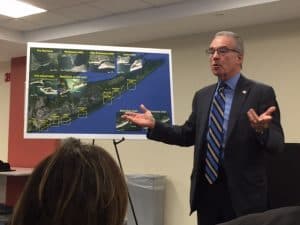 Speaking at a recent meeting of the Long Island Regional Planning Council, Stony Brook University Professor Dr. Malcolm Bowman, who is a climate scientist and environmentalist, described our region’s continued vulnerability to storm surge.
Speaking at a recent meeting of the Long Island Regional Planning Council, Stony Brook University Professor Dr. Malcolm Bowman, who is a climate scientist and environmentalist, described our region’s continued vulnerability to storm surge.
More than eight million people in the New York Metropolitan area are located in areas at risk of coastal flooding and almost 60 percent of its land area is within a meter of sea level, he said.
Dr. Bowman, Distinguished Professor of Physical Oceanography at Stony Brook University, and Chairman of the Metro NY/NJ Storm Surge Working Group, said the storm surge threat is compounded by rising sea levels. Methods of predicting and pinpointing storm surges, as well as proactive protection of vulnerable coastal areas, must be immediate priorities. He asserted that with bigger storms, we need to build storm surge barriers to save our region.
Dr. Bowman described his site visits to other cities, such as London, which began using underwater barriers in 1982, and the Netherlands, which following a storm in 1953, built a barrier system with a swinging gate that closes off vulnerable inlets in the event of a big storm. Other cities with barrier systems are St. Petersburg, Russia, and Venice, Italy, which has a hinge on the sea floor that swings up during storm surge.
The presentation was followed by a panel discussion, moderated by LIRPC Chairman John Cameron, who is also a member of the Metro NY/NJ Storm Surge Working Group, which included: Robert Kennedy, Mayor, Village of Freeport; Jack Schnirman, City Manager, City of Long Beach; Marcia Bystryn, President, New York League of Conservation Voters; and Mike DeNicola, Vice President, Hazen & Sawyer consultants.
Related Content
Presentation: Superstorm Sandy’s Catastrophic Flooding of Metropolitan New York
Footer
Contact
STAY INFORMED
Enter your email address to receive email updates from the LIRPC:


